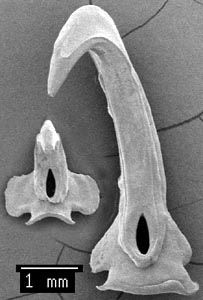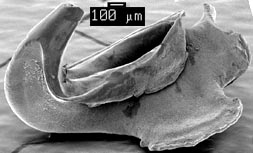Two club hooks were examined with the scanning electron microscope (SEM). Their relative sizes are seen in the photograph below. Hook number 7 from the proximal end of the ventral hook series (ie, hook V7) (right in photograph) was the largest of all the club hooks. Its mate from the dorsal hook series (hook D7) is seen on the left. Note the near bilateral symmetry of hook V7.


Figure. Frontal views of hooks D7 (left) and V7 (right) of O. robsoni (?), 145 mm ML, continental slope south of New England, USA . Photographs by R. Young.



Figure. Top-frontal view of the two hooks (V7 at left, D7 at right). The proximal lateral lobe in V7 is slightly smaller than the distal lateral lobe. The proximal lip of this hook lacks a hair-lip but the edge curls slightly at this position. The lateral claw grooves extend nearly to the tip of the claw. The claw tip of hook D7 is broken off.



Figure. Lateral views of the two hooks (hook V7 at left, D7 at right).



Figure. Attachment-site views of the two hooks (hook V7 at left, D7 at right).
Comments
Of the three species of Onykia examined with the SEM, the general appearance of O. robsoni is similar to O. robusta. The specimen of O. robsoni examined here is the same as that in the title photograph on the O. carriboea web page. Hooks from a larger (304 mm ML) specimen from the Gulf of Mexico looked similar but had a bit more asymmetry between the lateral lobes of the ventral-series hook.




 Go to quick links
Go to quick search
Go to navigation for this section of the ToL site
Go to detailed links for the ToL site
Go to quick links
Go to quick search
Go to navigation for this section of the ToL site
Go to detailed links for the ToL site